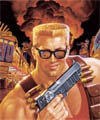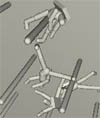GB Quotes
"And yes, we've been fundamentally tech complete for longer than a year."
Search
Poll
Is Gearbox doing a good job handling the Duke Nukem IP?
Yes
No
DNF Overview
Background Info
 Duke Nukem Forever (DNF) is the upcoming sequel to the best selling first person shooter game of 1996, Duke Nukem 3D. Though the game's plot is unknown at this time, there has been some speculation in regards to the storyline. We know for sure that the game will be set in Las Vegas, Area-51, and other imperative locations around the world. Duke Nukem, symbolized as "The King of Action," returns in DNF to kick more ass in a pragmatically interactive world of bad guys and babes.
Duke Nukem Forever (DNF) is the upcoming sequel to the best selling first person shooter game of 1996, Duke Nukem 3D. Though the game's plot is unknown at this time, there has been some speculation in regards to the storyline. We know for sure that the game will be set in Las Vegas, Area-51, and other imperative locations around the world. Duke Nukem, symbolized as "The King of Action," returns in DNF to kick more ass in a pragmatically interactive world of bad guys and babes.
Some History
Being infamous for delay, the game has been under development at 3D Realms studios since 1997. DNF’s game engine has gone through several updates and rewrites since 3D Realms first made the decision to switch from id Software's Quake engine to Epic's Unreal engine in 1998. George Broussard has commented that DNF’s highly modified version of Unreal looks very competitive in comparison with the current generation of technology featured in games.
Technical Info
Some of the following is a revised edit of information provided to us by 3D Realms forum member Firefly:
The Engine
 DNF utilizes a profoundly customized version of the Unreal engine. The only original data which remain unmodified are the scripting system and network code. The core engine modules have been completely reinstated by 3D Realms. We’d expect that the level editor looks different, too. Here’s an official quote from George Broussard, the project leader:
DNF utilizes a profoundly customized version of the Unreal engine. The only original data which remain unmodified are the scripting system and network code. The core engine modules have been completely reinstated by 3D Realms. We’d expect that the level editor looks different, too. Here’s an official quote from George Broussard, the project leader:
"We've completely gutted and written our own AI system, rendering, particles, skeletal animation and more, so it won't look or feel like an Unreal game at all."
The Renderer
The game uses a DirectX 9 compatible graphics renderer, featuring a"full HLSL pipe" and capable of supporting "pretty much […] any rendering mode or feature that cards can do." This includes SM3.0 which is "easy to support." The visibility system is also completely new, and static mesh support has been added. The game makes extensive—or in George’s words, "hardcore"—use of shaders. Characters are "normal mapped" using data generated from "500k-1m" poly models.
For the lighting, HDR is implemented and shadows are accurately calculated according to the positions of the light sources. George has indicated that this is done using stencil shadows, revealing that DNF’s lighting system is as advanced as Doom 3’s:
"You can't really tone down the shadows. They are all dictated by distance from a light, etc, so it's all ‘real.’ So you really just take what you get. I expect that people complaining about stencil shadows being hard lines, and dark, will be like people complaining that characters are pixelated when you walk up to them in Doom. It'ss imply the way it is with technology, right now."
Animation
DNF uses a skeletal animation based system, allowing multiple animation channels to blend in real time. In 2001,the system was capable of simultaneously using up to 16 channels, but typically only four to five were used at any one time. The animation system also uses some form of Inverse Kinematics, with the actual animation (as opposed to programmer numbers) determining how characters move through a level, as in Half-Life 2.
An in-house motion capture system is used as part of the animation process:
"With this, we can now integrate motion capture data easily for extremely life-like animation. You can also do all sorts of things with bones like making character's heads (or other body parts) track you. Or you can do limited IK on them, when you shoot a character in the shoulder, it can recoil and take the other bones with it."
Level Editor
DNF uses a modified version of the Unreal Editor, nicknamed by George as“Duke's Enormous Tool.” The editors are similar, but because underlying engine isn't, only the "core geometry and static meshes"can be imported from existing Unreal engine levels. According to George, any imported levels "would probably have to be re-built fromscratch to take advantage of our graphics engine and its features,"—the visibility and lighting systems being completely different across the two engines.
The new editor fixes several limitations, making the trigger system more flexible. For example, elevators with floor selectors can be implemented. Maps now only take "a few minutes (4-5?)" to process/compile and this is "much faster for smaller, localized changes in a map." This indicates that Unreal's pre-computed (or pre-compiled) lighting has been replaced by a fully dynamic/unified system.
Physics
Meqon. Several sites have also speculated that DNF will be using the latest generation of this technology, designed for next-gen consoles.
Game Distribution
3D Realms has also announced that their future games (possibly DNF) will likely use a Steam-like content delivery system in addition to traditional shelf distribution.
 Duke Nukem Forever (DNF) is the upcoming sequel to the best selling first person shooter game of 1996, Duke Nukem 3D. Though the game's plot is unknown at this time, there has been some speculation in regards to the storyline. We know for sure that the game will be set in Las Vegas, Area-51, and other imperative locations around the world. Duke Nukem, symbolized as "The King of Action," returns in DNF to kick more ass in a pragmatically interactive world of bad guys and babes.
Duke Nukem Forever (DNF) is the upcoming sequel to the best selling first person shooter game of 1996, Duke Nukem 3D. Though the game's plot is unknown at this time, there has been some speculation in regards to the storyline. We know for sure that the game will be set in Las Vegas, Area-51, and other imperative locations around the world. Duke Nukem, symbolized as "The King of Action," returns in DNF to kick more ass in a pragmatically interactive world of bad guys and babes.Some History
Being infamous for delay, the game has been under development at 3D Realms studios since 1997. DNF’s game engine has gone through several updates and rewrites since 3D Realms first made the decision to switch from id Software's Quake engine to Epic's Unreal engine in 1998. George Broussard has commented that DNF’s highly modified version of Unreal looks very competitive in comparison with the current generation of technology featured in games.
Technical Info
Some of the following is a revised edit of information provided to us by 3D Realms forum member Firefly:
The Engine
 DNF utilizes a profoundly customized version of the Unreal engine. The only original data which remain unmodified are the scripting system and network code. The core engine modules have been completely reinstated by 3D Realms. We’d expect that the level editor looks different, too. Here’s an official quote from George Broussard, the project leader:
DNF utilizes a profoundly customized version of the Unreal engine. The only original data which remain unmodified are the scripting system and network code. The core engine modules have been completely reinstated by 3D Realms. We’d expect that the level editor looks different, too. Here’s an official quote from George Broussard, the project leader:"We've completely gutted and written our own AI system, rendering, particles, skeletal animation and more, so it won't look or feel like an Unreal game at all."
The Renderer
The game uses a DirectX 9 compatible graphics renderer, featuring a"full HLSL pipe" and capable of supporting "pretty much […] any rendering mode or feature that cards can do." This includes SM3.0 which is "easy to support." The visibility system is also completely new, and static mesh support has been added. The game makes extensive—or in George’s words, "hardcore"—use of shaders. Characters are "normal mapped" using data generated from "500k-1m" poly models.
For the lighting, HDR is implemented and shadows are accurately calculated according to the positions of the light sources. George has indicated that this is done using stencil shadows, revealing that DNF’s lighting system is as advanced as Doom 3’s:
"You can't really tone down the shadows. They are all dictated by distance from a light, etc, so it's all ‘real.’ So you really just take what you get. I expect that people complaining about stencil shadows being hard lines, and dark, will be like people complaining that characters are pixelated when you walk up to them in Doom. It'ss imply the way it is with technology, right now."
Animation
DNF uses a skeletal animation based system, allowing multiple animation channels to blend in real time. In 2001,the system was capable of simultaneously using up to 16 channels, but typically only four to five were used at any one time. The animation system also uses some form of Inverse Kinematics, with the actual animation (as opposed to programmer numbers) determining how characters move through a level, as in Half-Life 2.
An in-house motion capture system is used as part of the animation process:
"With this, we can now integrate motion capture data easily for extremely life-like animation. You can also do all sorts of things with bones like making character's heads (or other body parts) track you. Or you can do limited IK on them, when you shoot a character in the shoulder, it can recoil and take the other bones with it."
Level Editor
DNF uses a modified version of the Unreal Editor, nicknamed by George as“Duke's Enormous Tool.” The editors are similar, but because underlying engine isn't, only the "core geometry and static meshes"can be imported from existing Unreal engine levels. According to George, any imported levels "would probably have to be re-built fromscratch to take advantage of our graphics engine and its features,"—the visibility and lighting systems being completely different across the two engines.
The new editor fixes several limitations, making the trigger system more flexible. For example, elevators with floor selectors can be implemented. Maps now only take "a few minutes (4-5?)" to process/compile and this is "much faster for smaller, localized changes in a map." This indicates that Unreal's pre-computed (or pre-compiled) lighting has been replaced by a fully dynamic/unified system.
Physics

Meqon. Several sites have also speculated that DNF will be using the latest generation of this technology, designed for next-gen consoles.
Game Distribution
3D Realms has also announced that their future games (possibly DNF) will likely use a Steam-like content delivery system in addition to traditional shelf distribution.













